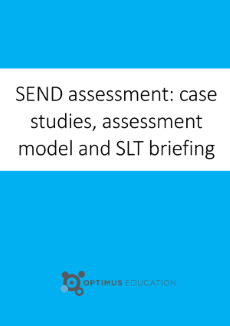There are many misconceptions surrounding the role of teaching assistants in a classroom. Research has shown that effective partnership between teacher and TA can greatly benefit provision.

Observe and record
It can be useful to conduct classroom observations that focus on a pupil’s behaviour and that enable the teacher and the TA to better understand the individual.
A TA can be tasked with this, preferably over several lessons (in secondary schools, it should involve lessons in different subject areas), recording information such as:
-
frequency of particular behaviour (e.g. shouting out, moving out of seat, ignoring instructions, distracting other learners)
-
reactions to different activities, teachers and environments (e.g. ‘Jack may be fine in Mrs Smith’s D&T lesson where he can move about and enjoy a practical activity, but is not so good in Miss Brown’s literacy lesson, where there is a lot of listening expected and he sits in a group of lively boys’)
-
amounts of time spent on or off task and the amount of work completed, compared with their peers
-
how different peers affect the pupil’s behaviour
-
strategies that seem to be effective.
‘A, B, C’ observation
Alternatively, or in addition, it may be appropriate to make an ‘A, B, C’ observation of the pupil:
-
A: antecedent – what happened to spark the unwanted behaviour (e.g. was it another pupil, a task that was too difficult, or a negative comment from the teacher?)
-
B: behaviour – describe the resulting response (e.g. lashing out, sulking, refusal to cooperate)
-
C: consequences – what happened afterwards (e.g. a warning or reprimand from the teacher, loss of a house point, moving into the ‘red zone’, another child getting upset) and how this affected subsequent working.
Analyse
Use the information collected above to determine:
-
what triggers unwanted behaviour
-
what that behaviour looks like
-
what works best in preventing/addressing it.
An important part of this process is talking to the child and gaining an understanding of their perspective.
Parents/carers may also be able to throw light on the causes of unwanted behaviour. In one instance, impending divorce and regular arguments over breakfast resulted in significant emotional stress for a child in Year 6. He reacted by being angry – with everyone, about everything. Only by talking to the parents was this issue uncovered and eventually resolved.
Respond
With careful thought, positive action may be taken straight away and can prove to be effective.
Discussion and joint decision-making between the teacher and the TA about these issues will help to ensure a consistent approach.
Consider making changes to:
-
how you set out your expectations, so that children understand
-
the level of difficulty of work given (is it currently too challenging – or too easy?)
-
seating position/grouping (a cushion on the carpet; nearer the teacher, away from distraction; with pupils who are good role models)
-
how you deliver instructions and explanations – use visual back-up where possible
-
the amount of choice afforded to the child
-
how you address constant fidgeting, perhaps providing a ‘stress ball’ or another way of occupying fidgety fingers
-
how the teacher and TA relate to the child – remember to praise good behaviour (from any child) to model and reinforce; be particularly vigilant in praising the child in question (this may be for minor achievements to start with); condemn the misbehaving, never the child
-
rewards and sanctions – these have to be relevant to the child, properly understood and consistently applied.
Our Behaviour Managament conference takes place on Wednesday 26 February in London. This conference will help you create a whole-school approach to behaviour that is proactive and takes into account the factors affecting individual children.
Find out more.
Prioritise
There will often be more than one aspect of a child’s behaviour that needs modifying, but it’s important to prioritise. Address one or two aspects at a time.
A behaviour plan, with SMART (specific, measurable, achievable, realistic, time-limited) targets can be drawn up with the child (and their parents/carers), and perhaps monitored by the TA.
Advice for TAs
Providing behavioural support during lessons is an important part of the TA’s role.
Establish a clear understanding between the teacher and the TA about responsibilities and parameters: the teacher is always ultimately responsible for the behaviour of the class, including the child with difficulties, and should never be undermined by support staff.
The practice of the TA talking to a child while the teacher is addressing the class is not to be encouraged. It indicates that the child doesn’t need to listen, like everyone else – and it distracts other pupils. If further or a different explanation is needed, take the child elsewhere, or wait until the teacher has finished talking.
Tips for TAs
Remember to:
-
reinforce the teacher’s expectations and behaviour management system
-
remind the child – in a positive way – of rules and how you/the teacher want them to behave
-
ensure the child’s understanding of instructions and how to succeed in the task
-
redirect the pupil back to the task when their attention wanders; give praise for perseverance
-
acknowledge every aspect of good behaviour – make sure the child knows you’ve noticed
-
anticipate when a ‘trigger point’ is approaching and step in quickly to avert a negative reaction
-
explain the choices that the child can make – and the consequences.
Try to avoid:
-
making exceptions for the child you are supporting; or ‘taking their side’ when they complain about the teacher
-
telling the child what NOT to do
-
delaying the start of independent activity or completing tasks for the child
-
being drawn into irrelevant conversation
-
highlighting minor misdemeanours, especially in front of the whole class
-
undermining the teacher’s authority
-
an escalation of poor behaviour.
More on strategies for teachers and teaching assistants
 Master SEND assessment
Master SEND assessment
Download our free toolkit of case studies, assessment models and an SLT briefing to help you develop your strategy for SEND assessment.
SEND assessment toolkit

 Master SEND assessment
Master SEND assessment